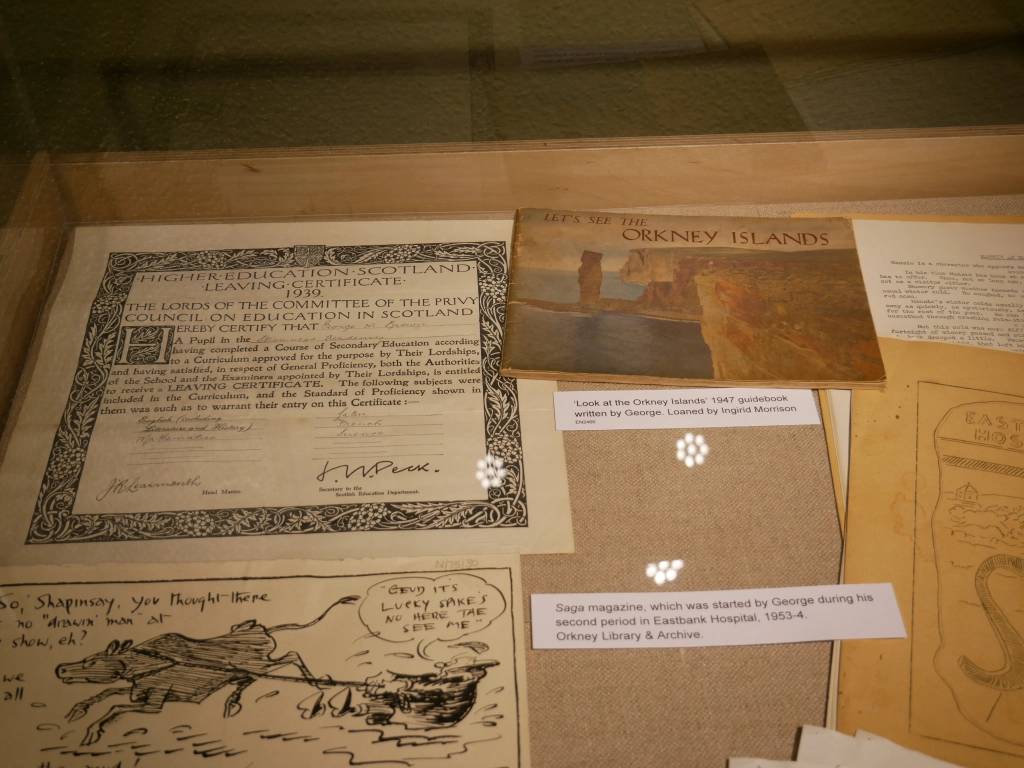Beside the Ocean of Time: The Centenary of George Mackay Brown

[Tom] The Orkney poet, George Mackay Brown, was born in Stromness on 17th October 1921. This, being his centenary year, the Orkney Museum are celebrating his life and work in the exhibition, ‘Beside the Ocean of Time’, named after his last novel. I thought that I would give you a taste of the exhibition, which will be on show until 30th October 2021. This ‘summer exhibition’ runs later than usual, and begins a month later too. This was to fit in with Covid 19 restrictions, allowing the previous exhibition to run a bit longer, due to the restriction on visitor numbers. It also takes in the date of his birth; it would seem strange if we ended it before the actual centenary. The reason that we are holding the exhibition in Kirkwall rather than it being in his home town of Stromness is that Stromness Museum had a wonderful exhibition that people were not able to visit last year, so that remains open. I worked closely with Stromness Museum and the Brown family in the creation of this exhibition. To simply ignore the centenary was not something that we could do. George is a major figure in not just Scottish poetry but is internationally respected and loved.

The exhibition includes many pieces belonging to George. The roundels depicting the cathedral builder, Jarl Rognvald Kali Kolsson (above, centre) is flanked by his father, Kol Kalisson (left) who oversaw the building of the St Magnus Cathedral, and Biship William the Old (right) who had Magnus cononised and who consecrated the building. These images were painted by the Orkney artist, Stanley Curister, as a working design for decoration for the St Rognvald Chapel in the cathedral. He eventually had full length figures carved by local craftsman and artist, Reynold Eunson to decorate the chapel, which is in the east end of the cathedral. The story of St Magnus and his nephew Rognvald in the Orkneyinga Saga was a major influence on George. He returned to the martyrdom of Magnus and Rognvald’s pilgrimage to the Holy Land in both stories and poems.

George was a highly sensitive child who hated school. He did remain there to take his highers, after which he was drafted to serve in the war. In 1940 he had a medical and was found to have tuberculosis, which meant he was unfit for service. He was sent to East Bank Sanatorium in Kirkwall, but at that time a diagnosis of TB was practically a death sentence. He responded to treatment and was allowed home, where he was cared for by his Sutherland born, Gaelic speaking mother Mhairi Mackay. His father had died suddenly of a heart attack that same year.


George attended Newbattle Abbey College under the mentorship of the Orkney poet Edwin Muir, who was the Warden of this new adult education college. While attending a second year there George took ill and had to return home. He was once more diagnosed with TB and was sent back to East Bank Sanatorium. While there he started a magazine called ‘Saga’ (above), which he edited and wrote for. Also in this picture is ‘Per Mare’, a pageant to mark the 150th anniversary of Stromness being made a Burgh of Barony in 1967, which was written by George. He also wrote a very popular weekly column for The Orcadian newspaper under the title of ‘Under Brinkies Brae’. Examples of his original hand written manuscripts can be seen here (bottom left). He wrote all his work in longhand.

The cartoon by ‘Spike’ in The Orkney Herald features George, who was a reporter for the newspaper under the name of ‘Islandman’ (bottom right). He is wearing his trademark scarf. This refers to a football match between Orkney and Shetland, which he was covering for the newspaper.














As well as text panels which tells the story of George’s life and works, there are also many photographs, both from his own photo album and from the Gunnie Moberg Collection in the Orkney Library & Archive. These photos shows some of the famous poets and musicians who came to Orkney because of the St Magnus Festival, which was founded by George and the composer Sir Peter Maxwell Davies, who features in three colour portraits above.
To make a donation to any of the museums please follow the link and support us. Thank you.
